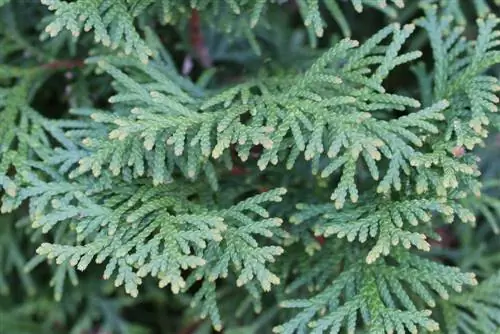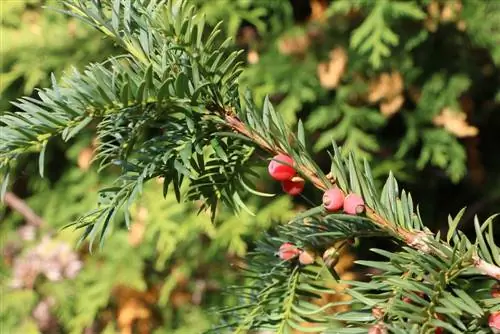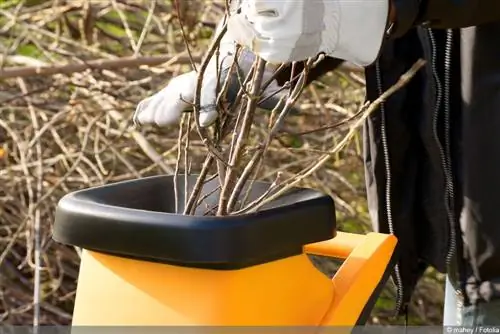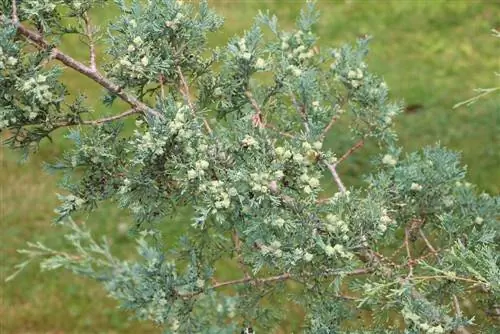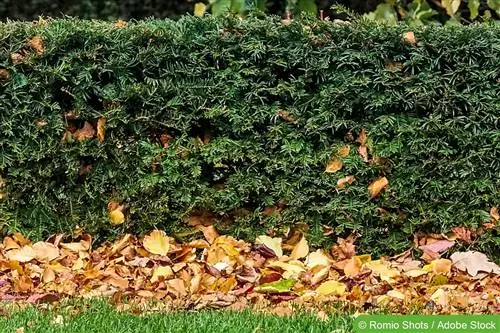- Author admin [email protected].
- Public 2023-12-17 03:39.
- Last modified 2025-01-24 12:45.
Fences are simply part of every property in this country. They provide boundaries and keep unwanted guests outside and strangers looking at them. However, the property owner has a lot of leeway when choosing a fence. Stones don't always have to be stacked or wooden boards screwed close together. Arborvitae, yews or false cypresses make ideal natural hedges. A direct comparison helps with the decision.
Tree of Life
The tree of life, botanically Thuja, is an old friend in home gardens. The species from North America are particularly popular due to their winter hardiness. These would be the Western Tree of Life and the Giant Tree of Life. Trees of life come from the cypress family. They can live almost 200 years and grow freely to a remarkable height of more than 20 meters.
Suitability as a hedge plant
Trees of life are hardy, inexpensive and fast-growing.
These are ideal conditions for a hedge that quickly forms a green wall and offers visibility and wind protection all year round.
- different growth forms
- green all year round, some varieties with winter foliage coloring
- Wild species are too vigorous
- The variety 'Martin' is dark green, narrow, conical shape
- grows about 45 cm per year
- 'Smaragd' and 'Brabant' grow slower, 20-30 cm per year
- ‘Emerald’ is very compact and has an emerald green color
- ‘Brabant’ offers golden green color and more open foliage
Note:
The trees of life still have an “old-fashioned” image, which is why they are no longer planted as often these days. However, as a hedge they offer so many benefits and are definitely worth considering.
Ideal conditions
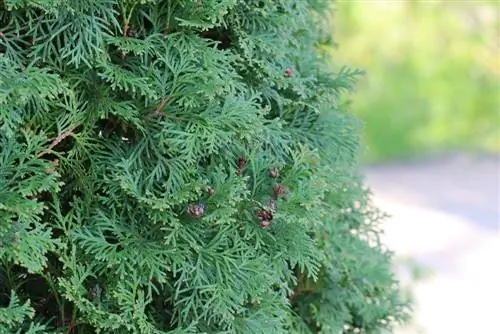
A tree of life is not equally suitable as a hedge everywhere. In order for the tree of life to develop well, the available location should suit it well.
- full sunny location
- light shade is tolerated
- the soil should be moist all year round
- calcareous and sandy loam soil
- If there is a good supply of humus, acidic soil is also suitable
Plants and care effort
Small and larger arborvitae are available at garden centers and nurseries. If there is already a tree of life in the garden, the population can also be increased using cuttings. Adult arborvitae are undemanding in care. Young or newly planted thujas, on the other hand, need more attention at the beginning of their hedge life.
- Ensure sufficient moisture in the first three years
- Mulch and provide humus in spring
Cutting work
To ensure that there are no holes in the hedge, you need to use secateurs skillfully with the tree of life.
- For dense and compact growth, cutting must be done
- twice a year for fast-growing specimens
- in June and the end of August
Pruning thuja plants also has its pitfalls. The pruning should neither be too severe nor into the old wood. Such mistakes when cutting quickly lead to sparse growth and bald spots that are difficult or impossible to correct.
Tip:
The cutter absolutely needs protective gloves and long-sleeved clothing when working. This hedge plant is poisonous in all parts. Contact with the shoots causes skin irritation and redness in sensitive people.
Yew
A yew is an evergreen conifer with protruding branches and soft needles. Botanically it is known as Taxus. It comes from the yew family. It blooms in spring and produces red fruits that are popular with birds. However, there are also fruitless varieties. As versatile as the more than 400 yew varieties are, their enormous toxicity must always be taken into account. If you have small children or pets, you should switch to another hedge plant or at least take timely information and protective measures.
Suitability as a hedge plant
The yew is one of the most popular hedge plants in this country. No wonder, because numerous properties make it an ideal hedge plant.
- it is fast growing and evergreen
- robust and impenetrable
- Yew is cut-resistant and easy to cut
- requires little maintenance
- is frost-proof
Tip:
'Hicksii' is a very popular variety for hedges. It is also known as the cup yew. It's best to take your time browsing through the variety of varieties and finding the ideal plant. Once planted, a hedge should last for decades.
Ideal conditions
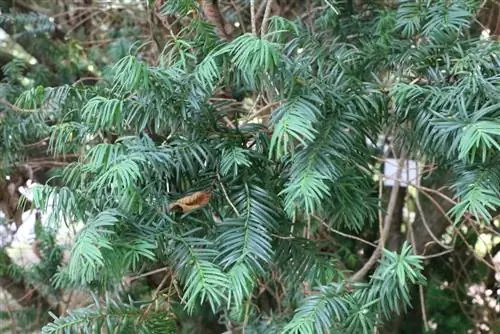
The optimal soil for a yew hedge must not be too wet, but always fresh and moist. The ideal soil is nutrient-rich and calcareous. If you can only offer sandy soil, you will still be lucky with the yew, as long as it is acidic and humus-like.
- Shady to semi-shady place is optimal
- Avoid the sun
- humid climates are better tolerated than dry ones
Plants and care effort
Yew trees can be propagated by sowing. However, they are available very cheaply in tree nurseries, so sowing them is not really worth it. If you're in a hurry, you can even use larger plants. Spring is the ideal planting time. Regular watering until rooting must be scheduled. Fertilize with compost once a year.
Tip:
Many nurseries also offer a volume discount for larger order quantities.
Cutting work
A yew hedge also involves a lot of work. The desired shape is not achieved through natural growth, so you have to use scissors regularly.
- must be brought into shape in the first summer
- Cutting work is due twice a year
- You can't go wrong when cutting
The yew tree offers a major advantage that arborvitae and false cypresses do not have: they always sprout well. Bare spots don't have to be tolerated for long on a yew hedge.
Mock cypress
The false cypress, bot. Chamaecyparis, is a close relative of the true cypress. The evergreen coniferous tree is quite similar to the tree of life, apart from a few subtle differences. Their growth is more upright and weaker. It can be found in more shades of color, ranging from yellow to blue-green.
Suitability as a hedge plant
Within the extensive range there are some varieties that fit well into a hedge. These are usually upright growing Lawson's false cypresses, also called Oregon cedar because of their origin. 'Alumii' and 'Columnaris' are two varieties that can be trained into an opaque hedge using secateurs. Different colored cypresses can be combined in a hedge. However, the resulting appearance is a matter of taste.
Ideal conditions
Cypresses tolerate more shade and more drought. A disadvantage is their higher sensitivity to frost.
- protected location
- sunny to partially shaded
- sandy-loamy soil
- moist soil and often high humidity
- may be alkaline to slightly acidic
Note:
All parts of the false cypress plant are poisonous. Direct contact may cause skin irritation and redness.
Plants and care effort
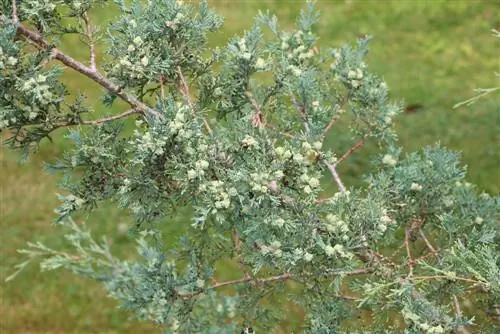
The easiest way to create a false cypress hedge is to buy young trees from a tree nursery or garden center. However, inexpensive tree extraction is also possible from so-called cracklings. These are side branches that are torn from the main stem. Newly planted false cypresses need to be watered well for a long time. Watering may also be necessary in winter. Especially after a long period of frost combined with a lack of precipitation. There is no further maintenance required, apart from the cut described below. Only adding compost in spring ensures a supply of nutrients.
Cutting work
The purpose of a hedge is often to enjoy your own privacy in the garden. Regular cutting brings the desired density. Fortunately, the false cypress tolerates pruning and can be easily shaped into the desired hedge shape.
- Topiary cutting must be done annually
- the right time is around St. John's Day (in June)
- avoid heavy pruning
- does not grow out of old wood
Tip:
Anyone who creates a hedge of false cypresses should know that there must be time for regular trimming. A hedge that has not been trimmed for several years will become out of shape. Even later, corrective cutting measures no longer produce the desired result.

